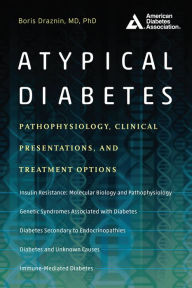Download amazon kindle book as pdf Atypical Diabetes: Pathophysiology, Clinical Presentations, and Treatment Options 9781580406666 English version by
Par larson beverly le jeudi, avril 29 2021, 22:02 - Lien permanent
Atypical Diabetes: Pathophysiology, Clinical Presentations, and Treatment Options. Boris Draznin

Atypical-Diabetes.pdf
ISBN: 9781580406666 | 560 pages | 14 Mb

- Atypical Diabetes: Pathophysiology, Clinical Presentations, and Treatment Options
- Boris Draznin
- Page: 560
- Format: pdf, ePub, fb2, mobi
- ISBN: 9781580406666
- Publisher: American Diabetes Association
Download amazon kindle book as pdf Atypical Diabetes: Pathophysiology, Clinical Presentations, and Treatment Options 9781580406666 English version by Boris Draznin
Atypical Diabetes: Pathophysiology, Clinical Presentations, and Treatment Options by Boris Draznin Although the vast majority of diabetes cases (type 1 and type 2) are polygenic diseases, research, funded by the American Diabetes Association, has found that some forms of diabetes, distinct from type 1 or type 2 diabetes, are caused by single gene mutations. It has been estimated that these monogenic forms of diabetes account for up to five percent of all diabetes cases. In addition to monogenic diabetes, there are other atypical causes of diabetes, including: genetic defects in insulin action; diseases of the exocrine pancreas; and endocrinopathies. Given recent advances in our understanding of sub-types of diabetes, the time has come for a book on how to correctly diagnose and treat patients with atypical forms of this disorder. The book will be divided into three parts, each exploring distinct categories of atypical diabetes. Part I: Monogenic Diabetes: Genetic Defects of β-cell development and function; Part II: Insulin resistance, genetic defects in insulin action, and diseases of exocrine pancreas; Part III: Endocrinopathies, Immune-mediated diabetes, Diabetes of Unknown cause, and Other genetic syndromes sometimes associated with diabetes.
Atypical presentation of atypical mycobacteria in atypical diabetes
Other baseline biochemical parameters remained noncontributory. In view of the absence of features suggestive of Type 2 diabetes (lean built, absence of acanthosis nigricans and a family history negative for diabetes), search for an alternative etiology was pursued. An erect abdominal skiagram revealed
Ketosis-Prone Atypical Diabetes: Glucagon Is There, Too - NCBI - NIH
Classification of diabetes. As stated by Zimmet et al. (1) in the initial chapter of a classical textbook on diabetes, the major requirement for orderly epidemiologic, genetic, and clinical research on diabetes and glucose intolerance, and indeed for their clinical management, is an appropriate classification.
2. Classification and Diagnosis of Diabetes | Diabetes Care
Type 1 diabetes and type 2 diabetes are heterogeneous diseases in whichclinical presentation and disease progression may vary considerably. determinants of type 1 and type 2 diabetes risk and progression, to determine appropriate therapeutic approaches based on disease pathophysiology and
Hyperosmolar Hyperglycemic State Clinical Presentation: History
Hyperosmolar hyperglycemic state (HHS) is 1 of 2 serious metabolic derangements that occurs in patients with diabetes mellitus (DM) and can be a life-threatening emergency. It is less common Other common symptoms include nausea, vomiting, weakness, lethargy, and muscle cramps. They do not
OMIM Entry - # 612227 - DIABETES MELLITUS, KETOSIS-PRONE
In addition to classic type 1 (see 222100) and type 2 (see 125853) diabetes mellitus, atypical presentations are seen, particularly in populations of African ancestry. (2008) reviewed the syndromes of ketosis-prone diabetes mellitus with regard to the natural history, pathophysiology, and treatment of the subgroups of KPD.
Links:
Free ebooks on j2ee to download Please Don't Take My Sisters by Maggie Hartley